Sometimes, all we might need is a little warmth. This can also hold true when experiencing shoulder pain.
Shoulder pain is a common problem that causes plenty of discomfort. Heat therapy, on the other hand, is a popular, age-old method of relieving pain.
But could something as simple as heat truly provide a good relief solution for your shoulder pain? Let’s jump into this hot topic and see for ourselves.
Is Heat Good for Shoulder Pain?
Yes, heat can be an effective treatment for shoulder pain. Heat therapy is a popular and traditional method that’s been used for musculoskeletal pain relief for ages. Neck pain and back pain are other examples where heat may apply.
Heat therapy is inexpensive, widely available, and easy to use at home. Despite these good qualities, always consult your doctor before turning to heat therapies for shoulder pain.
Shoulder pain can arise from various causes, and for the best outcome, a tailored medical treatment plan is recommended.
How Does Heat Therapy Treat Shoulder Pain?
Heat therapy works by increasing the temperature of the skin and muscles. An increased temperature has three main effects:
- It increases blood flow to the shoulder by opening smaller blood vessels.
- It increases metabolism.
- It changes the function of certain pain receptors.
These effects can lead to shoulder pain relief by:
- “Distracting the brain”
The changed pain receptors start sending fewer pain signals to the brain. The brain understands this change as less damage and, thus, less pain.
Some might worry that dampening this "alarm system" could be harmful, suggesting we’re addressing the root cause rather than just muting the alert. Yet, issues like muscle strains and sprains often heal on their own. Diminishing the pain in these cases is advantageous. Moreover, stress can amplify pain, so reducing this exaggerated pain response is beneficial.
- Promoting tissue healing
More blood to the damaged tissues means they heal faster and more efficiently.
- Increasing tissue elasticity
More blood flowing to the connective tissues around the shoulder increases their elasticity. An increase in elasticity can improve the healing process.
How Do I Use Heat for Shoulder Pain?
There are plenty of ways you can use heat to treat shoulder pain. We’ve listed below the best and most effective heat therapies for shoulder and neck pain.
1. Heating Pads

A heating pad is one of the most effective forms of heat therapy for neck and shoulder pain relief. As the name suggests, a heating pad is a compress that provides warmth to a body region. Heating pads are available in various forms:
- Electric heating pads
These pads use electricity to generate heat. They represent the most practical and popular heating pad type. Why’s this? Well, they have adjustable heat settings, so you can pick the heat level that suits your needs. However, they need a continuous power source.
- Soft-Heated Packs (Microwaveable Pads)
These are bags filled with a type of grain, such as wheat or flax seed. Here’s how you can use them:
-
- First, put the bag on a plate.
- With the plate, put the bag in the microwave or oven and heat. However, note that some heating pads are not recommended for oven use. Always check the manufacturer's instructions.
- After a few minutes, take the plate out and turn the microwave or oven off.
- Apply the heated bag or pack to the painful shoulder region.
Soft-heated packs are also known as microwaveable pads. They don’t leak water and can take the shape of the shoulder or blades. They’re portable and don't require a power outlet.
- Chemical heating pads
A chemical heating pad produces heat through a chemical reaction that happens inside the pad. This type of pad can be disposable or reusable.
- Hot water bottles or bags
These bottles or bags represent a more traditional heating option. They’re made of rubber and filled with hot water.
2. Warm Wraps
A hot or warm wrap may be another quick and hot solution for shoulder pain. The easiest way to prepare a warm wrap is to use a towel. All you need to do is:
- Dampen a towel with warm water.
- Apply it directly over your shoulder(s).
Be careful not to use scalding water, as you might burn your skin.
According to a 2013 study, moist heat may be more effective for sore muscle relaxation than dry heat. By providing moist heat, warm wraps can be more effective against shoulder muscle pain than dry-heat pads.
3. Hot Stone Therapy
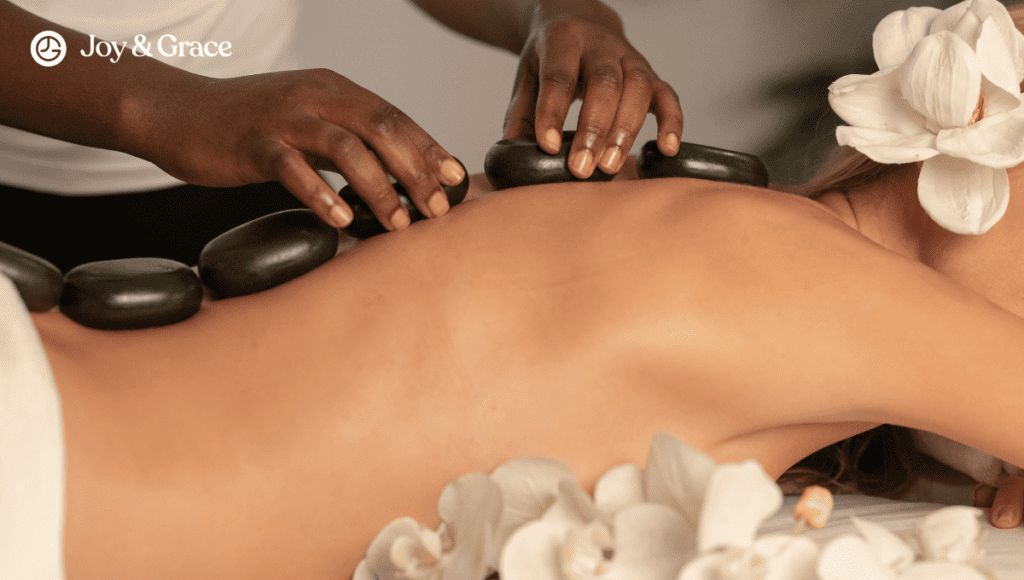
Hot stone therapy makes use of heated stones. These stones can be applied to your painful shoulder region. Hot stone therapy can be combined with massage therapy to relax tense muscles.
4. Poultices
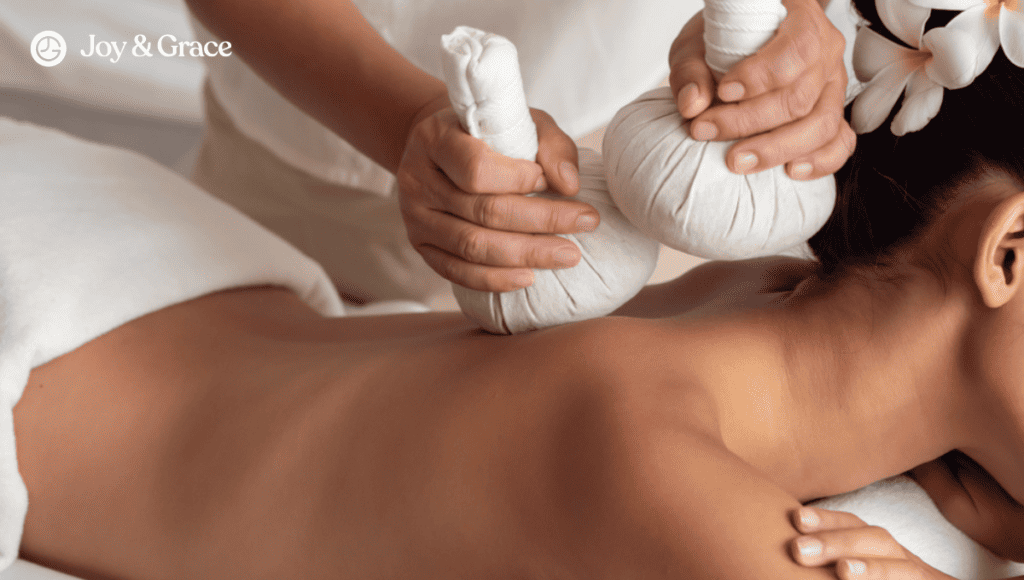
A poultice (also known as a cataplasm) is a soft, moist mass made from herbs or flour. Poultices are mainly used short-term for wounds, bruises, sprains, or strains. But how can you prepare poulticesHere’s a guide on how to prepare a fresh-herb poultice at home:
- Decide which herbs you’d like to use. Beloved anti-inflammatory herbs include plantain, chickweed, calendula, dandelion, and burdock.
- Estimate how much you’ll ne
- ed. The amount of herb depends on the size of the targeted neck area.
- Chop the herbs you’ve picked into small pieces on a cutting board.
- Transfer the herbs to a mortar and pestle and crush them until they become a pulp. As you chop and mash, the herbs will release their natural juices, and the leaves will become softer. You can also use a blender instead of a cutting board.
- Spread the crushed herbs on your neck. Apply it evenly across the area.
- Wrap the area with a layer of gauze to hold the paste in place.
5. Paraffin Wax
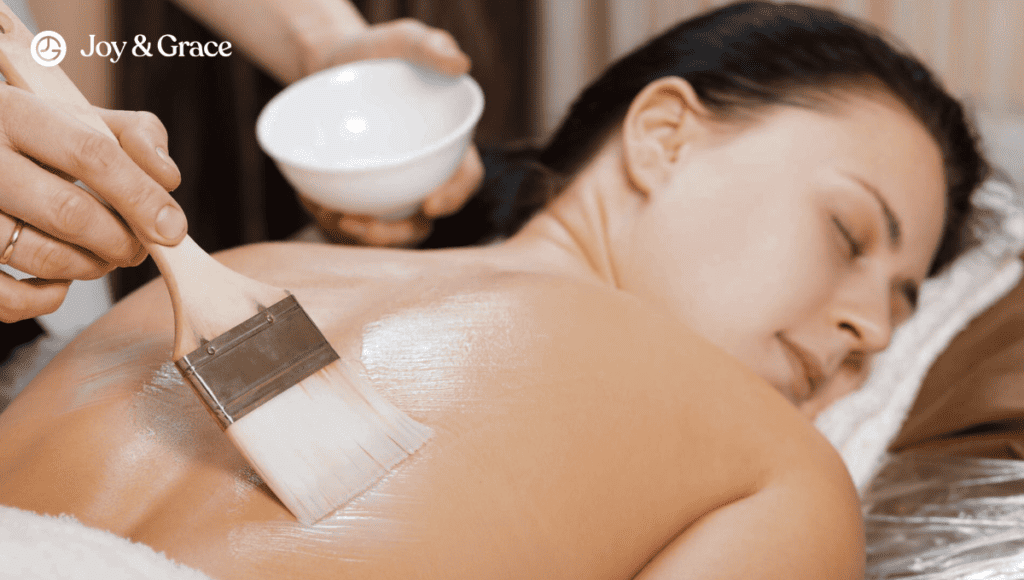
Paraffin is a type of wax commonly used by physiatrists (PM&R specialists). When applied to the shoulder, paraffin can improve blood flow and loosen stiff joints. Consult your physiatrist to discover how to use paraffin.
6. Hot Baths and Sauna
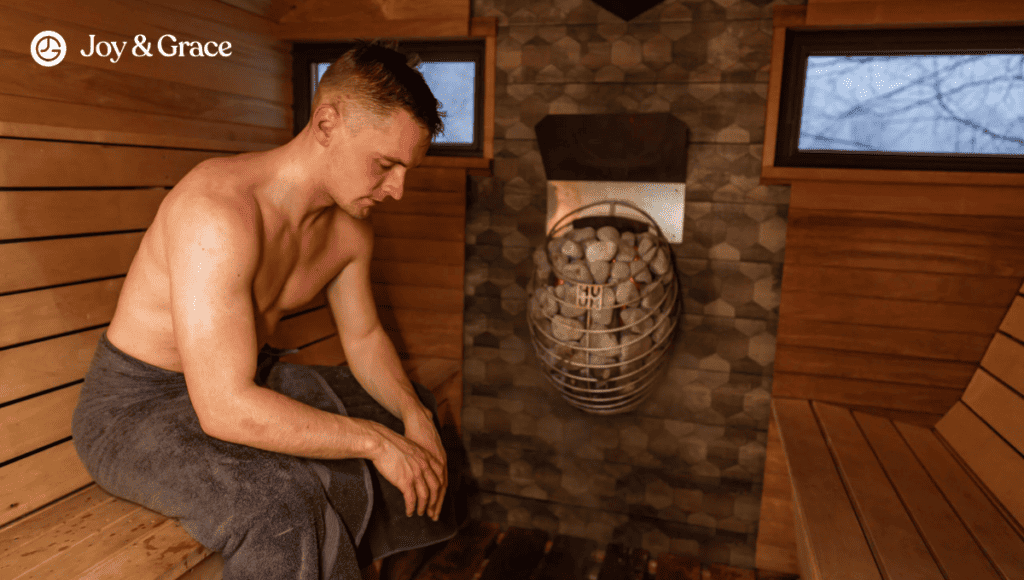
Few things are more relaxing than a hot bath. The steam and hot water of a hot bath can increase blood circulation and loosen shoulder muscle tension. Get your hot bath ready and soak your shoulders and body for 10-15 minutes. Make sure the water is not too hot, especially if you have heart problems. A temperature between 92 and 100 degrees usually works for most people.
Time spent in a sauna can have similar effects on pain as a hot bath. If you’ve never used a sauna before, start with a period of 5-10 minutes and work up to around 20. The appropriate temperature for a sauna is up to you. Most people prefer temperatures between 150-175 degrees for a traditional sauna.
7. Heat Gels and Creams
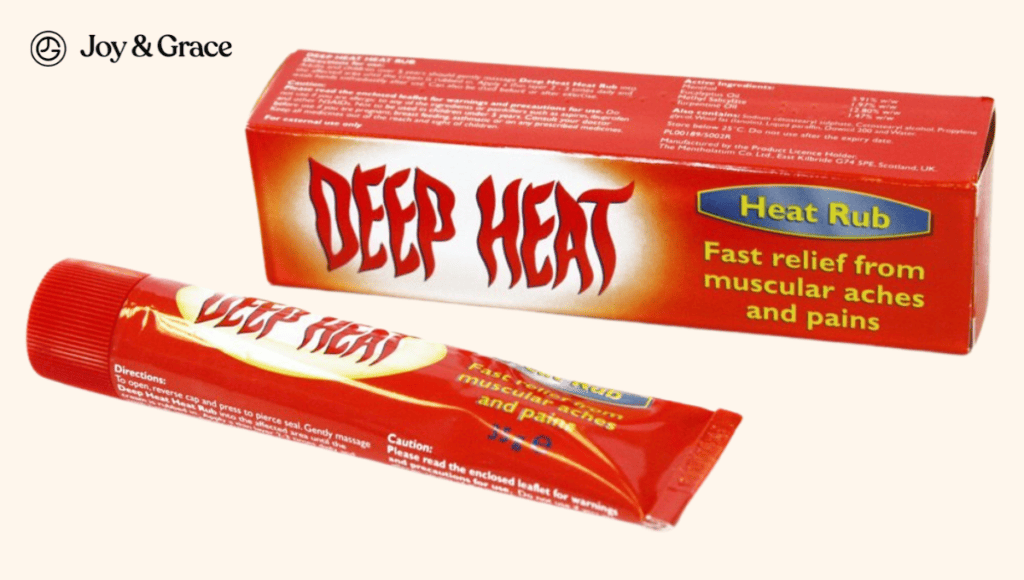
Topical heat gels and creams are often used for relief from muscle aches and pains. When applied to the skin, these products create a warming sensation. This sensation is often due to ingredients like capsaicin or menthol.
Gels and creams are convenient, portable, and can be applied multiple times a day. It's always essential to follow the product's directions and avoid using them with other heat sources to prevent burns or irritation.
8. Infrared Heat Lamps
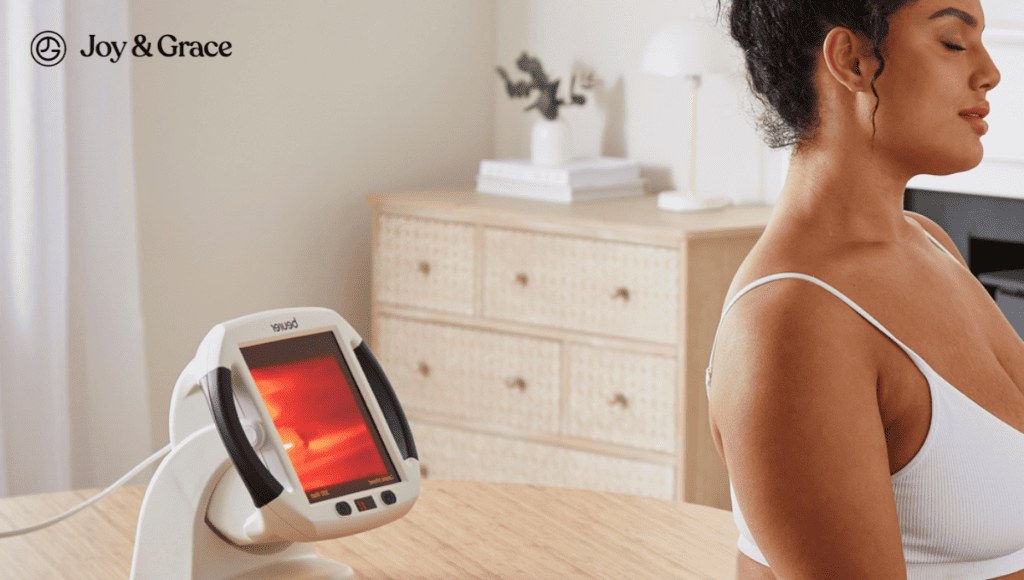
Infrared radiation (IR) is radiation that certain heat lamps (or other hot objects) can emit. A 2022 study review shows that infrared radiation can be a potential therapy for musculoskeletal and chronic pain.
According to the review, IR may potentially have positive effects against pain in the following conditions:
- Fibromyalgia (a generalized health condition that causes body aches, tiredness, and trouble sleeping)
- Osteoarthritis (a disorder that causes joint degeneration)
- Sleep-related disorders
- Muscle and bone damage from athletic injuries
The review also reports no significant side effects. However, we suggest you consult your doctor before starting IR therapy.
9. Deep-Heat Therapy
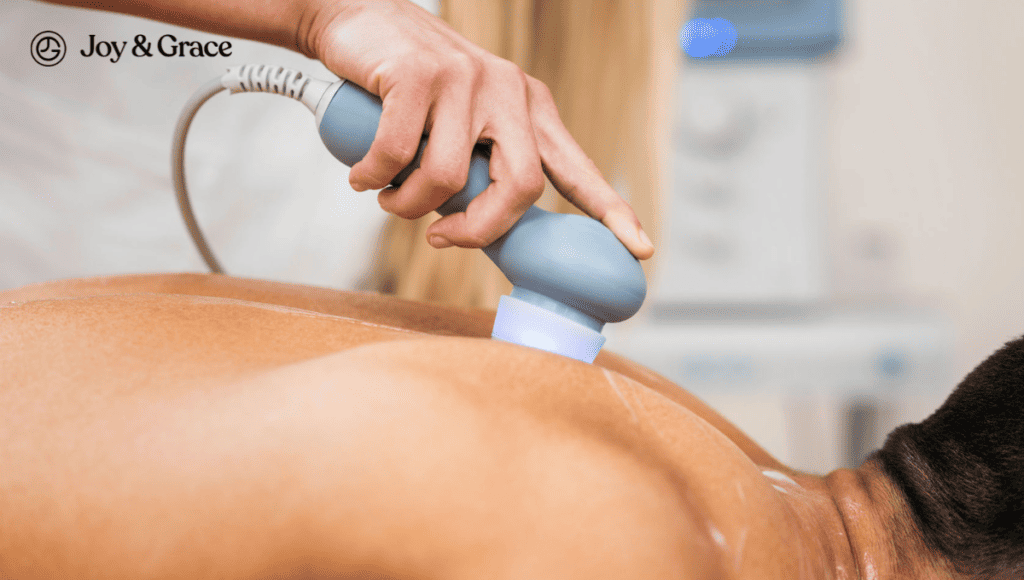
So far, we’ve talked about heat therapies that are applied superficially to the skin. The application of deep heat is, as the name suggests, deeper.
Deep heat is produced when energy is converted into heat as it passes through body tissues. This conversion causes rapid increases in tissue temperatures. These increases can provide therapeutic effects for shoulder pain.
Energy can result from the following:
- High-frequency currents (shortwave diathermy)
- Very-high-frequency electromagnetic radiation (microwave diathermy)
- High-frequency sound (ultrasound diathermy)
- Inflammatory and degenerative conditions
- Tendonitis (inflammation of muscle tendons)
- Tenosynovitis (inflammation of the tendon sheath where muscles connect to bone)
- Bursitis (inflammation of the bursal sac)
- Osteoarthritis (degeneration of joints)
- Rheumatoid arthritis (autoimmune and inflammatory joint disease)
- Muscle spasms
- Injuries (shoulder strains or sprains)
- Contractures and adhesion (deformities of rigidity of joints)
Don’t hesitate to consult your doctor if you’re uncertain what method to start or continue with. Some methods may be more successful for your shoulder pain than others.
When to Use Heat for Shoulder Pain
Heat therapy works best for the treatment of the following shoulder-related conditions:
- Chronic shoulder and neck pain
Chronic shoulder and neck pain is defined as discomfort persisting in these regions for more than 3-6 months. Chronic pain may be debilitating and decrease life quality.
- Stiff shoulder joints
A stiff shoulder joint may arise from shoulder (glenohumeral) joint dysfunction. One of the most common causes of shoulder joint stiffness is a condition known as ”frozen shoulder” or adhesive capsulitis.
- Delayed-onset muscle soreness (DOMS)
You might’ve had this condition before without even realizing it. DOMS is the feeling you usually get after unfamiliar or intense exercise. It’s also known as “muscle fever”. In DOMS, your muscles feel sore or painful. DOMS results from temporary muscle damage and inflammation after exercise.
In addition, heat can help with a sore or stiff neck and acute lower back pain.
Heat therapy may synergize with other shoulder pain treatment methods. This means that the mentioned effects of heat may be more pronounced when heat is combined with:
- Painkiller medications
- Physical exercise
- Massage therapy
- Lifestyle changes
Is Heat or Ice Better for Shoulder Pain?
The truth is that both heat and ice are effective remedies for shoulder pain relief. A 2015 study tells us that heat and cold can benefit musculoskeletal pain differently. While heat could be better for shoulder pain in some cases, ice could apply in others.
If you’re suffering from chronic shoulder pain or pain between shoulder blades, try heat therapy. As mentioned, heat can also provide better results than ice for sore muscles.
Have you had an injury recently? Then an ice pack could be your best bet. Cold therapy (cryotherapy) is great for shoulder and neck pain from acute injuries. Ice has more benefits when applied in the first 48-72 hours after an injury.
Should I Ice or Heat My Shoulder First?
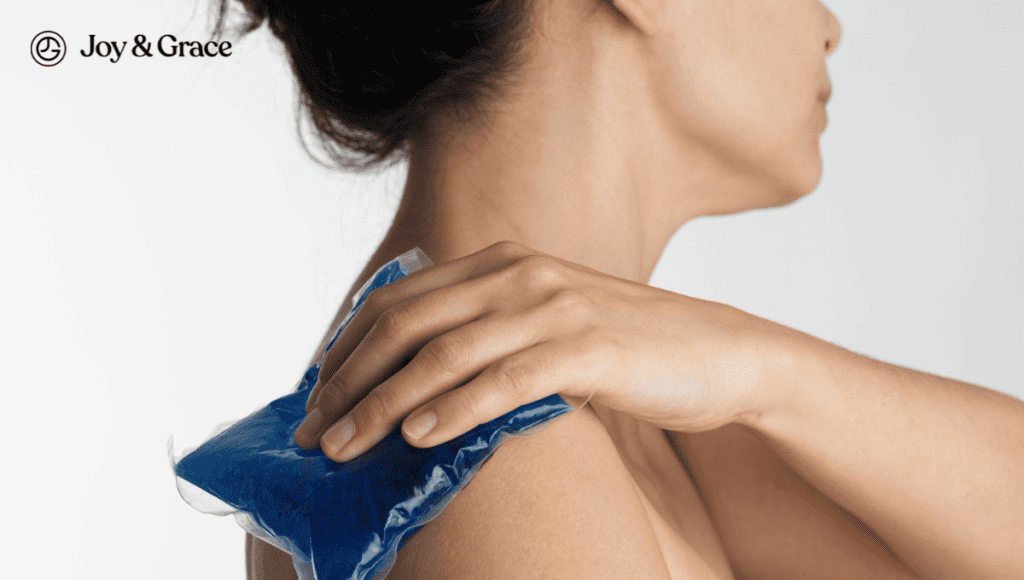
When dealing with a more unusual situation, such as a shoulder injury, you might wonder what to do for your pain. If you have a painful shoulder from an injury, try ice first and heat after. An icy, cold compress may help reduce shoulder inflammation immediately. Ice can numb the pain-signaling nerve endings in the shoulder area and provide quick pain relief.
Heat, on the other hand, has the opposite effect as cold. It may be more effective 2-3 days after the shoulder pain and inflammation from the injury have settled down.
You can also try alternating between heat and ice. For example, you can apply a hot compress to your shoulder and neck for 15-20 minutes. Then, you can wait a few hours and apply a cold pack to the painful region for 10-20 minutes. You may then repeat the same cycle.
Note: Don’t apply ice and heat to your shoulder at the same time! When used together, their effects may cancel each other out.
Safety of Heat Therapy

Heat therapy for shoulder pain is generally safe. Adverse effects are rare and minor. The most commonly reported side effect is “localized skin pinkness” in the shoulder. Skin pinkness is usually nothing to worry about and goes away within hours.
Before using heat for pain relief, keep in mind to:
- Avoid overheating.
Overheated modalities can damage the skin and cause burns.
- To ensure optimal comfort, modify the pad's warmth as needed.
The lowest heat setting on your pad may still be too hot for you. Avoid the discomfort by carefully placing a thin towel or cloth between the pad and your neck. If the heating pad is a microwavable one, let it cool slightly before applying. Always take steps to ensure you're comfortable and safe.
- Follow instructions carefully.
For example, if you want to use a microwaveable pad, place it on a plate before heating it in the microwave. After taking the plate out of the microwave, turn the microwave off.
- Don’t fall asleep or forget about the pad.
Leaving a pad or wrap unattended can burn and damage your skin.
Bonus Info: What Commonly Causes Shoulder Pain?
Shoulder pain can result from various causes, which can be categorized into four main groups:
- Tendon inflammation and tears
- Bursitis. Bursitis represents the inflammation of the bursa. The shoulder bursa is a small, fluid-filled sac that cushions and lubricates the shoulder joint.
- Tendonitis. Tendonitis is the inflammation of tendons. Tendons connect muscles to bones. Thus, they’re vital to the function of muscles and joints.
- Tendon tears. Shoulder muscle tendon tears (rotator cuff tears) are severe conditions that can cause excruciating shoulder pain.
- Bursitis. Bursitis represents the inflammation of the bursa. The shoulder bursa is a small, fluid-filled sac that cushions and lubricates the shoulder joint.
- Shoulder instability (dislocation)
Shoulder instability happens when the bones disconnect at the shoulder joint. This may result from overuse or an injury.
- Arthritis
Arthritis is the wear-and-tear degeneration of the shoulder joint. The most common type of arthritis in the shoulder joint is osteoarthritis.
- Broken bones (fractures)
Shoulder fractures usually follow a shoulder injury and can involve:
-
- The upper arm bone (humerus)
- The collarbone (clavicle)
- The shoulder blade (scapula)
Diagnosis and Treatment of Shoulder Pain

Diagnosing shoulder pain is a step-by-step procedure. Your healthcare provider will:
- Take your medical history
- Perform a physical examination of your shoulder
- Order imaging tests (if necessary)
- X-rays
- Ultrasound
- MRI (Magnetic Resonance Imaging)
- CT (Computed Tomography)
- Electrical studies
- Arthroscopy
- Arthrogram
After coming up with the correct diagnosis, your doctor can devise a treatment plan. While shoulder pain can be treated at home, your doctor may suggest additional treatment methods. These can include:
- Painkiller medications (Tylenol, Ibuprofen)
- Shoulder exercises (physical therapy)
- Massage therapy or yoga
- Lifestyle changes (diet, sleep)
- Surgery, when conventional treatment options don't work or the damage is severe
When to See a Doctor?
At times, heat therapy may not be enough for shoulder pain relief. We recommend you seek medical care early, especially if:
- You have sudden or bad shoulder pain
- The pain started after an injury or accident, like a fall
- You can’t move your arm
- Your arm or shoulder has changed shape or is swollen
- You have pins and needles that don’t go away
- Your arm or shoulder is numb
- Your arm or shoulder is hot or cold to touch
- You feel feverish or unwell
- You have additional symptoms, such as severe abdominal or chest pain.
Takeaway
Heat can be an effective treatment for shoulder pain.
Heat therapy works by increasing the temperature of the skin and muscles. An increased temperature has three main effects:
- It increases blood flow to the shoulder by opening smaller blood vessels.
- It increases metabolism.
- It changes the function of certain pain receptors.
These effects can lead to shoulder pain relief by:
- “Distracting the brain” (reducing the number of pain signals)
- Promoting tissue healing
- Increasing tissue elasticity
The best heat therapy modalities for shoulder and shoulder blade pain include the following:
- Heating Pads
- Warm Wraps (such as a damp towel)
- Hot Stone Therapy
- Poultices
- Paraffin Wax
- Hot Baths and Sauna
- Infrared Heat Lamps
- Deep-Heat Therapy
Heat therapy works best for the treatment of the following shoulder conditions:
- Chronic shoulder and neck pain
- Stiff shoulder joints
- Delayed-onset muscle soreness (DOMS)
Cold therapy (cryotherapy) is great for shoulder and neck pain from acute injuries. Ice has more benefits when applied in the first 48-72 hours after an injury.
When dealing with a shoulder injury, try ice first and heat after a few days. You can also try alternating between heat and ice, but don’t apply them to your shoulder at the same time!
Heat therapy for shoulder pain is generally safe. Adverse effects are rare and minor. The most commonly reported side effect is “localized skin pinkness” in the shoulder.
Before using heat for pain relief, keep in mind to:
- Avoid overheating.
- To ensure optimal comfort, modify the pad's warmth as needed.
- Follow instructions carefully.
- Don’t fall asleep or forget about the pad.














